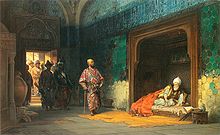Bayezid I.


Bayezid I. (بایزید بن مراد / Bāyezīd b. Murād ; * 1360 ; † 8./9. March 1403 in Akşehir ), calledیلدرم / yıldırım / 'the lightning', was Sultan of the Ottoman Empire from 1389 to 1402 .
Life
Family life
Bayezid succeeded his father Murad I on the throne after he was killed in the battle of the blackbird field in 1389 . He immediately had his brother Yakub murdered, thus establishing a long tradition: fratricide when taking office was common among the sultans of the Ottoman Empire until the 17th century. His mother was the Valide Sultan Gülçiçek Hatun, who came from Greece . Bayezid first married Devlet Shah Khatun, daughter of the Emir of Germiyan , whose dowry included Kutahya and adjacent territories. She was the mother of Mehmed I , who restored the Ottoman Empire in 1413. Two years before his accession to the throne, Bayezid married a daughter of the Byzantine emperor Johannes Palaiologos . He was also married to Olivera Despina .
Wars
Most of his campaigns were very successful. Immediately after taking office, he conquered several West Anatolian Beyliks such as Aydın , Germiyan and Menteşe , who had allied themselves with the caramans , a powerful Central Anatolian dynasty , in 1391 and 1392 . He then besieged the caraman's capital, Konya , forcing his rivals to recognize his conquests. But there was no time to conquer the Beylik, as the new Byzantine emperor Manuel II. Palaiologos , who actually owed tribute to the Ottoman Empire, as well as Wallachia and Bosnia began to occupy Ottoman territories in Rumelia . Bayezid reversed these developments in a lightning campaign: Bulgaria was conquered in 1394, and Wallachia became an Ottoman vassal state in 1394 . In 1395 he suffered a defeat at Rovine against the troops of the Wallachian voivode Mircea cel Bătrân and their guerrilla tactics.
Now Bayezid turned against the Eastern Roman Empire, whose territory consisted almost exclusively of the capital Constantinople. By skillful diplomacy he succeeded in preventing the Venetian grain deliveries to the Bosporus. He had the Anadolu Hisarı fortress built on the Asian bank of the Bosphorus and enclosed Constantinople by land and sea for seven years. Startled by the impending fall of East Era, the Hungarian King Sigismund organized a crusade , in which mainly Burgundian knights and soldiers took part. In September 1396 Bayezid won a brilliant victory over the Crusaders in the battle of Nicopolis . As a result, his troops penetrated to northern Greece and Syrmia .
In the meantime, the caramans had taken the opportunity of the sultan's absence and regained their old capital, Ankara . In 1397 they suffered a devastating defeat and lost their territory to the Ottoman Empire, which Bayezid integrated into the new Beyerbeylik Anatolia . He also reached further north and east, conquering Sinope , Eretna and in 1400 Erzincan . As a result, however, he touched the sphere of influence of the Turkic Mongolian ruler Timur Lenk (also called Tamerlan ), who was building a world empire from his home in Transoxania . In order to be armed against this opponent, Bayezid ordered the siege of Constantinople to be broken off in 1401, but had the emperor reward the withdrawal of his troops dearly: Manuel II had to promise a resumption of tribute payments as well as the establishment of a mosque and the installation of a qadī in accept his city.
The dispute with Timur was unfavorable: In the battle of Ankara on July 20, 1402, the Ottoman army under Bayezid's command was subject to a superior force of Turkic Mongolian warriors. The sultan was captured and died a few months later in the Anatolian city of Akşehir. His sons accepted the suzerainty of Timur and divided the Ottoman Empire among themselves, so that for a decade there was no sole Turkish sultan.
power
Up until this defeat, Bayezid had been a very successful sultan: under his rule, the empire had reached its greatest expansion at 690,000 km². Through trading privileges for the maritime republics of Genoa and Ragusa , he also contributed economically to an opening of his empire. Bayezid was also active as a builder, for example in the construction of the port facilities of Gallipoli or the Great Mosque of Bursa . As the first Ottoman ruler, he was appointed sultan by the caliph , who was then based in Cairo , and thus the supreme ally for Islam .
reception

The story of the once powerful sultan who languished in the dungeon of the cruel emir inspired many artists to create imaginative designs. The English author Christopher Marlowe (1564–1593) processed the subject in his tragedy Tambourlaine the Great , which premiered in 1587/88. Dealing with Bayezit is portrayed as one of many acts of hubris that Tamerlane ultimately has to pay with his life. The French baroque poet Jean Magnon († 1662) then concentrated in his tragedy Le Gran Tamerlan et Bejezet entirely on the encounter between the emir and the sultan, as did Georg Friedrich Handel (1685–1759), whose opera Tamerlano was premiered in London in 1724 . In 1735 Antonio Vivaldi (1678–1741) staged his opera Tamerlano / Bajazet in Verona . Even in popular histories of the story was always told again, such as in Joseph von Bulow in 1860 published "memorabilia from the European history of attracting world events" for which the Austrian artist Johann Nepomuk Geiger created imaginative illustrations.
The Polish history painter Stanisław Chlebowski created his oil painting "Sultan Bajazyt of Tamerlan imprisoned" in 1878, which can be seen today in the picture gallery of the Ukrainian city of Lviv .
literature
- Hans-Jürgen Kornrumpf: Bayezid I. In: Biographical Lexicon for the History of Southeast Europe. Volume 1. Munich 1974, p. 163 f. ( biolex.ios-regensburg.de ).
- Klaus-Peter Matschke: The cross and the half moon. The history of the Turkish wars. Artemis & Winkler, Düsseldorf and Zurich 2004 ISBN 3-538-07178-0 .
- Josef Matuz: The Ottoman Empire. Baseline of its history. 5th edition, Wissenschaftliche Buchgesellschaft, Darmstadt 2008 ISBN 3-534-20020-9 .
- Ferenc Majoros, Bernd Rill: The Ottoman Empire 1300-1922. The story of a great power. Marix, Wiesbaden 2004, ISBN 3-937715-25-8 .
- Gabriel Effendi Noradounghian : Recueil d'actes internationaux de l'Empire Ottoman 1300–1789. Volume I. Paris, Neufchâtel 1897 (Reprint: Kraus, Nendeln 1978, ISBN 3-262-00527-4 ).
- Bayezid I. In: Encyclopædia Britannica . 11th edition. tape 3 : Austria - Bisectrix . London 1910, p. 556 (English, full text [ Wikisource ]).
Web links
Individual evidence
- ↑ Josef Matuz: The Ottoman Empire. Baseline of its history. 5th edition, Wissenschaftliche Buchgesellschaft, Darmstadt 2008, p. 41.
- ↑ To the following Josef Matuz: The Ottoman Empire. Baseline of its history. 5th edition, Wissenschaftliche Buchgesellschaft, Darmstadt 2008, p. 41 ff.
- ↑ Klaus-Peter Matschke: The cross and the half moon. The history of the Turkish wars. Artemis & Winkler, Düsseldorf and Zurich 2004, p. 85.
- ↑ Barbara Tuchman : The distant mirror. The dramatic 14th century. Paperback edition, dtv, Munich 1982, pp. 498–502.
- ↑ Josef Matuz: The Ottoman Empire. Baseline of its history. 5th edition, Wissenschaftliche Buchgesellschaft, Darmstadt 2008, p. 44.
- ↑ Klaus-Peter Matschke: The cross and the half moon. The history of the Turkish wars. Artemis & Winkler, Düsseldorf and Zurich 2004, p. 94.
| predecessor | Office | successor |
|---|---|---|
| Murad I. |
Sultan of the Ottoman Empire 1389–1402 |
Mehmed I. |
| personal data | |
|---|---|
| SURNAME | Bayezid I. |
| ALTERNATIVE NAMES | Bāyezīd Yıldırım |
| BRIEF DESCRIPTION | Sultan of the Ottoman Empire |
| DATE OF BIRTH | 1360 |
| DATE OF DEATH | March 8, 1403 or March 9, 1403 |
| Place of death | Akşehir |
